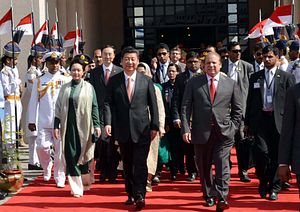Meeting with envoys from the Association of South East Asian Nations (ASEAN) (namely Malaysia, Indonesia, Vietnam, Philippines, Brunei, and Myanmar) in Aiwan-e-Sadr on April 19, Pakistani President Mamnoon Hussain expressed his desire to boost relations with ASEAN. He specifically mentioned Pakistan’s intention to seek a Full Dialogue Partnership (FDP) with the organization, which aims at strengthening political, trade, and economic ties with ASEAN member states. He admitted that Pakistan’s trade with ASEAN is well below its potential.
ASEAN is a promising area for trade, investment, and connectivity. In terms of trade potential, ASEAN is the seventh largest trading area in the world. The combined GDP of the ten ASEAN nations is over $2.4 trillion. It is a hub for regional trade and manufacturing activities and is emerging as one of the fastest growing consumer markets in the world. As the region seeks to deepen its ties and capture an even greater share of global trade, its economic profile is rising. Thus, for Pakistan, it is crucial to understand ASEAN and its potential.
Other countries have a head start in this regard. Historically, Japan has played a significant role in uplifting the ASEAN economies. Now China is making progress, proposing to build the 21st century Maritime Silk Road through Southeast Asia under its “One Belt and One Road” initiative. India, meanwhile, is pursuing its goals in the region under the vibrant “Act East” policy of Prime Minister Narendra Modi. The policy is yielding its results. India’s trade with ASEAN, Northeast Asia, and Oceanic countries has topped $200 billion.
The desire to boost Pakistan’s relations with ASEAN, as expressed by President Mamnoon Husain, is a good thing, but the question is how to boost relations. Looking at Pakistan’s trade and diplomatic relations with East Asia, there are many weaknesses and constraints.
Pakistan has weak links with the region, as it does not form an important economic and institutional space with ASEAN. Indian relations with ASEAN are robust, but Pakistan is lagging behind. Despite “Vision East Asia,” the strategy devised in 2004 to activate economic relations with ASEAN, ASEAN-Plus Three, and Oceanic countries, Pakistan’s interactions in terms of institutional arrangements are not increasing to any satisfactory level. Instead, Pakistan is falling behind.
Since the 1990s, Pakistan’s leaders have made numerous pledges to take Pakistan’s trade with ASEAN to new heights but no concrete measures were adopted and no specific policies were implemented. The rhetoric is strong, but words have not translated into actions and policymaking. Except with China, Pakistan’s trade with East Asia (particularly with ASEAN) has seen only modest growth for many years.
In 2013, Pakistan did $6.6 billion in two-way trade with ASEAN, $1.9 billion with Japan, and $1.3 billion with South Korea. Trade with Australia and New Zealand accounted for only $619 million and $112 million respectively in the same period. Considering Indian trade with the region amounts to over $200 billion, Pakistan needs step up its trading game many times over. Similarly, Pakistan’s investment relations with the ASEAN region are fairly weak. Pakistan received only $81 million in investment from ASEAN in 2014.
Pakistan’s diplomacy with East Asia is similarly lacking. Seeking an FDP with ASEAN is an old cry and yet it has not materialized. In the past few years, there have been no high-level visits paid by Pakistani leaders to ASEAN or Northeast Asia (with the exception of China). Islamabad has virtually ignored South Korea, Japan, and Australia.
Since assuming office in 2013, Prime Minister Nawaz Sharif has made 65 foreign visits to 28 countries, but none to East Asia (again, with the exception of China). Similarly, there have been no presidential visits to East Asian countries. If the same trend persists, East Asia would be nothing but a distant region in Pakistan’s foreign policy; “Vision East Asia” will be a failure.
Today, the Vision East Asia policy has become an irrelevant, unproductive, and forgotten initiative. An economically liberalizing Pakistan has not been able to benefit from the ASEAN miracle. This trend needs to be drastically reversed.
There is ample room for cooperation under the China-Pakistan Economic Corridor (CPEC) framework. A few ASEAN members made pledges to take part in the CPEC but so far their participation has been non-existent. The CPEC can not be developed effectively if ASEAN is disinclined to function as a regional hub, connecting Pakistan’s Gwadar port with Southeast Asia under the maritime initiative to link up regional ports. Yet these considerations have not taken up by Pakistan, which keeps its chief focus on road connectivity with China and Central Asia. India’s “Act East” policy, meanwhile, is countering the Chinese Maritime Silk Road and invariably will impact the CPEC. To reap the benefits offered by China’s Maritime Silk Road, Pakistan needs to be proactive in Southeast Asia.
Ahmad Rashid Malik is a Senior Research Fellow at the Institute of Strategic Studies Islamabad. He writes on East Asian affairs.

































